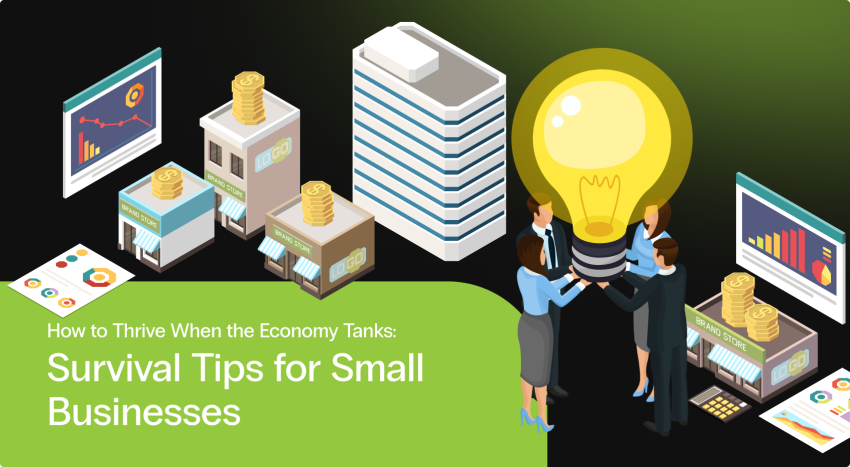How to Thrive When the Economy Tanks: Survival Tips for Small Businesses
Economic downturns can feel like the business equivalent of a bad breakup—everything’s uncertain, and your instincts are all over the place. When customer spending tightens and market conditions become unpredictable, many business owners find themselves scrambling just to keep the lights on. But here’s the thing: tough times don’t just create challenges; they also create opportunities for the bold, the creative, and the prepared.
Having navigated a few tough patches myself at Click Click Media, I’ve seen firsthand how resilience and strategy can turn potential disasters into growth opportunities. Let’s dive into some practical, actionable steps—with a healthy dose of humour, of course—to help you not just survive but thrive when the economy takes a nosedive.

Step 1: Get Real About Your Costs
Here’s the tough love: You can’t outrun your costs. When the economy tanks, controlling expenses isn’t just smart—it’s survival 101. But slashing expenses blindly can harm your business in the long run. The goal is to trim the fat, not the muscle.
Smart Ways to Cut Costs:
- Audit Your Fixed Expenses: Negotiate leases, utilities, and supplier contracts for better rates. Even a little haggling can save you big over time. Don’t be afraid to shop around.
- Eliminate Non-Essentials: That software subscription you forgot you had? Cancel it. The fancy office snacks? Downgrade to something less bougie. Focus on spending only where it delivers clear value.
- Streamline Operations: Invest in technology or processes that can reduce manual labour, cut waste, or improve efficiency. For example, at Click Click Media, we’ve invested in automated reporting tools that save hours of manual work—a win for both productivity and the bottom line.
Real-World Example:
Readings, an independent Melbourne bookshop, embraced technology during COVID-19 by launching an online store and streamlining inventory management. These changes helped them stay competitive while cutting costs (Source: The Age).
Step 2: Build Unshakeable Customer Relationships
When times get tough, customers become picky—and rightly so. This is your chance to shine by strengthening relationships and proving you’re worth every dollar they spend.
How to Stand Out:
- Proactive Communication: Keep customers informed about changes, new offerings, or added value. Transparency builds trust, even if the news isn’t always rosy.
- Add Value Without Breaking the Bank: Offer loyalty rewards, discounts, or extra perks for repeat customers. A little goodwill goes a long way.
- Exceptional Service Every Time: Go above and beyond to create positive experiences. At Click Click Media, we make it a point to follow up on every campaign to ensure clients are happy and know we’re invested in their success. It’s not rocket science, but it’s surprising how rare this level of care can be.
Real-World Example:
Sydney’s Two Providores pivoted during the pandemic from wholesale food distribution to direct-to-consumer sales, building deeper relationships with their new customer base while maintaining exceptional service standards (Source: SMH).
Step 3: Diversify Your Revenue Streams
Relying on a single revenue source in volatile markets is like putting all your eggs in a very unstable basket. It’s time to spread those eggs around.
Ideas for Diversification:
- Launch New Products or Services: Look for gaps in the market you can fill. Maybe there’s an unmet need your business is uniquely positioned to address.
- Explore Alternative Sales Channels: Expand to online platforms, partnerships, or subscription models. If your business isn’t online yet, now is the time.
- Leverage Existing Assets: Got underutilised resources? Find ways to monetise them. For instance, a commercial kitchen might rent out space to budding food entrepreneurs.
Real-World Example:
Frank Green, an eco-friendly Australian company, started with reusable cups and expanded into lifestyle products, creating entirely new revenue streams (Source: Broadsheet).
Step 4: Market Smarter, Not Harder
When the economy tanks, marketing budgets are often the first to go—a classic mistake. Visibility is critical, especially when customers are cautious. Instead of cutting back, double down strategically.
Marketing Moves That Work:
- Focus on High-ROI Channels: Digital marketing, email campaigns, and organic social media offer cost-effective ways to stay top of mind.
- Speak to Their Pain Points: Refine your messaging to show how your business solves their immediate problems.
- Love Your Existing Customers: Retarget loyal customers who already trust you. It’s far cheaper (and more effective) than chasing new ones.
Real-World Example:
Who Gives A Crap, the cheeky Aussie toilet paper company, used witty, transparent marketing to thrive during tough times, strengthening its brand and customer loyalty (Source: SmartCompany).
Step 5: Embrace Agility
The ability to pivot quickly is what separates survivors from casualties in a tough economy. This is where small businesses have a distinct advantage over lumbering giants.
How to Stay Flexible:
- Keep a Finger on the Pulse: Monitor market trends and adjust your strategies accordingly.
- Test and Iterate: Experiment with small changes before rolling out big ones. For example, we tested new campaign structures at Click Click Media during uncertain times, and those small tweaks led to some of our best-performing strategies.
- Empower Your Team: Encourage employees to share insights and ideas. Often, they’re closest to the problem—and the solution.
Real-World Example:
Bellroy, a Melbourne-based company, thrived during global uncertainty by diversifying its product line and leveraging e-commerce to expand its reach (Source: The Australian).
Action Plan: How to Thrive Through Tough Times
Here’s your survival kit:
- Audit Your Finances: Identify areas to cut costs without compromising quality or growth potential.
- Deepen Customer Connections: Build trust through proactive communication, exceptional service, and value-driven offers.
- Diversify Revenue: Reduce reliance on one income stream by exploring new products, services, or channels.
- Invest Wisely in Marketing: Stay visible with targeted, cost-effective campaigns that address your customers’ biggest concerns.
- Stay Nimble: Be ready to pivot, adapt, and embrace change. The faster you adjust, the stronger you’ll emerge.
Resilience Wins
Economic downturns are tough, but they’re also a proving ground. By focusing on what you can control—your costs, customer relationships, and adaptability—you’ll not only survive but thrive. Remember, the businesses that make it aren’t the ones waiting for better times; they’re the ones creating them.
And if you’re ever in doubt, just think back to the toilet paper shortage of 2020. Who Gives A Crap didn’t just sell rolls—they sold reassurance, reliability, and a bit of humour when we needed it most. Be that business.

